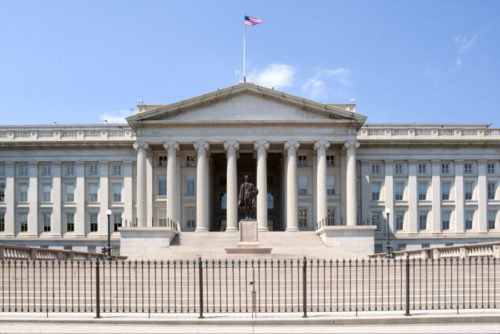Table of Contents
What Is Interest on the National Debt?
National debt is the public debt the government carries, which is the money it owes to other lenders besides its own government. As a consumer, when you take out a loan with a lender, you agree to loan terms, which includes an interest rate you must pay in addition to the loan balance. The government agrees to these same terms with a lender when it borrows money from outside entities.
The federal government has debt with foreign central banks, individuals, and businesses. Most of this debt is carried in notes, bonds, Treasury bills, and other types of securities. This public debt is all grouped together and referred to as the national debt.
The national debt is different from its deficit because the government deficit refers to the amount of debt the federal government carries when compared to the money it brings in. However, the debt itself refers to the money the government has borrowed over the years to cover this deficit.
While the federal government also owes money to federal agencies and the Social Security Trust fund, this debt isn’t part of the public debt. It’s considered intragovernmental debt because the government needs to eventually pay it back to itself and not to an outside lender. There’s no additional interest on intragovernmental debt since it’s internal debt, so it doesn’t count toward the interest on the national debt.
National Debt Interest Rate
Since the government has many debts with different lenders, there may be different terms with each loan, including varied interest rates. The higher an interest rate on debt, the more the borrower must pay. The lower the interest rate, the less the borrower owes on top of the loan balance.
When calculating its interest, the federal government adds the interest it owes collectively on all debt into one figure. As of 2020, the interest on national debt is $479 billion.
How Is It Calculated?
When the federal government uses Treasury bills as loans, the interest rate associated with these bills varies. The amount of the bill and when it was issued are factors that contribute to the interest rate associated with the debt. Interest rates are set based on demand in the market, so these rates may differ from one bill to the next, depending on when the government took on this debt.
When there’s a big demand for Treasury bills, the interest rate is generally low. However, when the demand is low, the interest rate increases and the federal government owes more interest on these bills. To calculate the federal government’s current interest rate, you would need to separate all these debts and their respective interest rates, then add up these calculations.
How Much of the Federal Budget Goes to Interest on the National Debt?
When the federal budget is created, the interest on national debt is taken into consideration. This interest must be addressed in the budget to ensure the federal government is still considered a credible and trustworthy borrower with outside entities.
The amount of the federal budget that goes to interest on the national debt depends on the current interest rates on Treasury bills. Since this interest rate varies, so does the percentage of the budget that’s applied to interest on the national debt. For example, by the end of 2010, public debt was over $9 trillion and 10-year Treasury bill interest rates averaged 3.21%. The government set aside 5.7% of the federal budget to pay for the interest on the national debt.
By the close of 2020, the interest rate on a 10-year Treasury bill is expected to be at 0.6%. In April 2020, the U.S. public debt was $24.97 trillion. The government plans to set aside 8.7% of federal spending in 2020 to cover the interest on the national debt. As the years go by, the interest on public debt continues to increase, so the percentage of the federal budget that’s used to cover this interest also increases.
What Interest on the National Debt Means For You
While increasing interest on the national debt may not seem to directly affect you and your household budget, this growing interest does have an effect on the country as a whole. As the United States continues to increase its debt by borrowing from different sources, these lenders may become concerned about the country’s ability to ever repay the debt. When defaulting on debt is a concern for lenders, these lenders may begin to charge even higher interest on additional debt the federal government borrows.
A high amount of interest on the national debt takes away from other programs that benefit U.S. citizens. Each year, the federal budget is forced to allocate a higher percentage to interest on the national debt, since this interest continues to increase. When more of the federal budget goes toward this interest, other federally funded programs are neglected, which has a negative impact on the state of the union.
As interest on the national debt rises, the Social Security Trust Fund eventually may not be able to cover the Social Security benefits that seniors qualify for. It’s projected that Social Security funds may be depleted by 2035. Benefit amounts may need to be reduced or the government may need to find another solution, such as privatizing the program or raising taxes.
How the Government Reduces Interest
When interest on national debt gets out of control, there are a few ways the government can reduce it, such as:
- Lowering the interest rate: The Federal Reserve has the power to lower interest rates but this is only done in extreme circumstances when all economic factors are in line.
- Raising taxes: The federal government can increase the revenue it has to address interest by raising taxes and reducing tax cuts available to U.S. taxpayers.
- Slowing spending: Interest on debt increases as the debt increases. When the government slows its spending, the interest on public debt won’t increase as quickly.
- Reconfiguring the federal budget: In addition to reducing the budget, the federal government may also focus its spending more on programs that promote economic growth, such as job creation. This stimulates the economy and may lead to lower interest rates.
Interest on the national debt continues to increase as public debt increases. The interest is addressed with a percentage of the federal budget. The rising interest on national debt has an impact on U.S. citizens because it takes away from other programs and threatens Social Security program funding.
Image Source: https://depositphotos.com/





